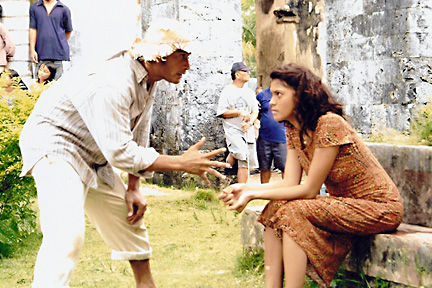
|
Drama in dialect of Cebu
explores WWII occupation
Even though the Hawaii International Film Festival Spring Showcase recently finished, Honolulu audiences won't have to wait until fall to enjoy a challenging international film. Award-winning actor/director Cesar Montano and his wife, Philippine film star Sunshine Cruz, are presenting the U.S. premiere of his new film, "Panaghoy sa Suba (The Call of the River)," at the Hawaii Theatre on Friday, and it will be something unusual even for locals who are well-versed in Filipino filmmaking. For one thing, the dialogue is in Cebuano rather than Tagalog.
Love triangleU.S. premiere of "Panaghoy sa Suba (The Call of the River)"Where: Hawaii Theatre When: 2:30 p.m. and 7 p.m. Friday Tickets: $20 VIP seating and $15 general admission (with proceeds to the Organ Donor Center of Hawaii), available at the Blaisdell Center box office, by phone at 528-0506, and online at www.hawaiitheatre.com Call: 591-2211
|
Cebuano (Montano says the language can also be called Visayan) is one of nine major languages that are spoken in various parts of the Philippines. It is also one of those spoken by the Filipinos who came to Hawaii before World War II. The majority were Ilocanos from the northern provinces of Luzon, but there were also a few Tagalog speakers from central Luzon, and Visayans from the south.
Although the story takes place in a part of the Philippines where Visayan is spoken, Montano has other reasons for not doing the film in Tagalog or English. He compares it to Hawaiian filmmakers working on Hawaiian-language plays and films, and says it is important to continue the tradition of Philippine filmmaking in the other regional languages.
Aesthetically, he intends the film to display the natural beauty of the Loboc River and its environs, while also telling a compelling story about love, loyalty, jealousy and patriotism during World War II.
"There are several beautiful tourist spots in Bohol, and one of them is the Loboc River ... and I said to myself that I should make a movie out of this beautiful place, and that catapulted everything (into production). I brought my screenwriter there for him to behold the place, and started on the love story on the river during World War II."

Cesar Montano won best director for "Panaghoy sa Suba" at the 2004 Metro Manila Film Festival.
In that context, the triangular relationship between the woman, the American and the Japanese officer is allegorical in representing the Philippines being jealously coveted by both the United States and Japan before and during the war.
Not everybody gets it. Some Filipino critics apparently felt Montano's detailed portrayal of traditional pre-war Visayan society slowed the action more than necessary. There were also complaints that the character of the Japanese army officer, played by Jacky Woo, was too sympathetic, and that Filipinos don't like reading English subtitles.
Montano responds that one of the reasons he made the film was to illustrate the tempo of life in the Visayas before World War II, and that a scene in which a character is imprisoned and tortured by the Japanese is historically accurate in representing that side of the story. Not every Japanese character is a stereotypical two-dimensional villain, but the atrocities committed by the Japanese are included in ample detail.
AS FOR the choice of language and location, another reason for making the movie was to review the Visayan or Cebuano film industry, and encourage others to make films there. If that means that some of the nuances of the Visayan dialogue are lost to nonspeakers, then so be it. (One of Montano's defenders claims that 70 percent of moviegoers in the Philippines understand the language well enough to follow the action without the subtitles).
Among Montano's upcoming projects as a producer/director is an epic treatment of Visayan patriot Francisco Dagohoy's war of national liberation against Spanish rule in the 1800s. It too will be filmed in Bohol and, as much as possible, in the areas where Dagohoy and his men campaigned against the Spanish.
As for "Panaghoy sa Suba," it comes to Honolulu with an impressive list of honors and awards in the Philippines that include Best Director kudos for Montano at the 2004 Metro Manila Film Festival and the Gawad Tanglaw Awards, where it also won Best Picture and Best Screenplay honors.
Montano and his film will be going to the Tokyo Film Festival, the Prague Film Festival in the Czech Republic, and then to Cannes in May.
But in the meantime, Honolulu audiences should heed the call of the river Friday night.
[News] [Business] [Features] [Sports] [Editorial] [Do It Electric!]
[Classified Ads] [Search] [Subscribe] [Info] [Letter to Editor]
[Feedback]
